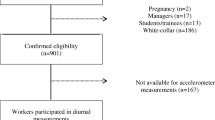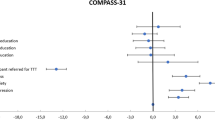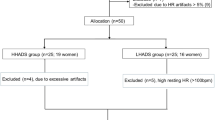Abstract
Objective: The aim of the present study was to compare autonomic activity, pressure-pain thresholds, and subjective assessments of health and behavior between patients with stress-related illnesses and healthy control subjects.Methods: Twenty sick-listed patients with stress-related illnesses and 20 age- and gender-matched healthy subjects performed tests of autonomic regulation and algometric tests, and completed questionnaires about physical and mental health and behavioral patterns.Results: Patients exhibited higher autonomic reactivity to cognitive and physical laboratory tasks (p<0.05), and had lower pressure-pain thresholds in the shoulders and lower back than healthy control subjects (p<0.05). Furthermore, the patients rated considerably poorer health and health behavior than the control subjects (p<0.05).Conclusions: The results indicate an engagement of the autonomic nervous system in stress-related illnesses. Furthermore, they show that patients with stress-related illnesses experience symptoms of musculoskeletal pain, and it is therefore recommended that assessments of musculoskeletal pain be incorporated in the clinical examinations and the rehabilitation of patients with stress-related illnesses.
Similar content being viewed by others
References
Andersson, M., Bagby, J.R., Dyrehag, L., & Gottfries, C. (1998). Effects of staphylococcus toxoid vaccine on pain and fatigue in patients with fibromyalgia/chronic fatigue syndrome.European Journal of Pain, 2(2), 133–142.
Astin, J.A., & Forys, K. (2004). Psychosocial determinants of health and illness: integrating mind, body, and spirit.Advances in Mind-Body Medicine, 20(4), 14–21.
Bergman, S., Jacobsson, L.T., Herrstrom, P., & Petersson, I.F. (2004). Health status as measured by SF-36 reflects changes and predicts outcome in chronic musculoskeletal pain: A 3-year follow up study in the general population.Pain, 108(1–2), 115–123.
Christ, F., Nehring, I., Abicht, J., Baranov, V., Kotov, A., Gartside, I., Glamble, J., & Messmer, K. (1998). Changes in the arteriolar volume pulse of the finger during various degrees of tilt using near infra-red and red photoplethysmography.European Journal of Medical Research, 3(5), 249–255.
Collins, P.A., & Gibbs, A.C. (2003). Stress in police officers: A study of the origins, prevalence and severity of stress-related symptoms within a county police force.Occupational Medicine (London), 53(4), 256–264.
Dahlgren, A., Åkerstedt, T., & Kecklund, G. (2004). Individual differences in the diurnal cortisol response to stress.Chronobiology International, 21(6), 913–922.
De Vente, W., Olff, M., Van Amsterdam, J.G., Kamphuis, J.H., & Emmelkamp, P.M. (2003). Physiological differences between burnout patients and healthy controls: blood pressure, heart rate, and cortisol responses.Occupational and Environmental Medicine, 60 Suppl 1, i54–61.
Edwards, D., Burnard, P., Coyle, D., Fothergill, A., & Hannigan, B. (2000). Stress and burnout in community mental health nursing: A review of the literature.Journal of Psychiatric and Mental Health Nursing, 7(1), 7–14.
Goldberg, R., Boss, R.W., Chan, L., Goldberg, J., Mallon, W.K., Moradzadeh, D. Goodman, E.A., & McConkie, M.L. (1996). Burnout and its correlates in emergency physicians: Four years’ experience with a wellness booth.Academic Emergency Medicine, 3(12), 1156–1164.
Grossi, G., Perski, A., Evengård, B., Blomkvist, V., & Orth-Gomér, K. (2003). Physiological correlates of burnout among women.Journal of Psychosomatic Research, 55, 309–316.
Grossi, G., Soares, J.J., Angesleva, J., & Perski, A. (1999). Psychosocial correlates of long-term sick-leave among patients with musculoskeletal pain.Pain, 80(3), 607–619.
Holm, S. (1979). A simple sequentially rejective multiple test procedure,Scandinavian Journal of Statistics, 6, 65–70.
Holte, K.A., Vasseljen, O., & Westgaard, R.H. (2003). Exploring perceived tension as a response to psychosocial work stress.Scandinavian Journal of Work, Environment, and Health, 29(2), 124–133.
Hurrell, J.J.J. & Murphy, L.R. (1996). Occupational stress intervention.American Journal of Industrial Medicine, 29, 338–341.
Iacovides, A., Fountoulakis, K.N., Kaprinis, S., & Kaprinis, G. (2003). The relationship between job stress, burnout, and clinical depression.Journal of Affective Disorders, 75(3), 209–221.
Jenkins, C.D., Rosenman, R.H., & Friedman, M. (1967). Development of an objective psychological test for the determination of the coronary-prone behavior pattern in employed men.Journal of Chronic Diseases, 20, 371–379.
Kecklund, G. & Åkerstedt, T. (1992). The psychometric properties of the Karolinska sleep questionnaire.Journal of Sleep Research, 1, 113.
Kendall, N.A. (1999). Psychosocial approaches to the prevention of chronic pain: the low back paradigm.Best Practice and Research Clinical Rheumatology, 13(3), 545–554.
Kennedy, G., Abbot, N.C., Spence, V., Underwood, C., & Belch, J.J. (2004). The specificity of the CDC-1994 criteria for chronic fatigue syndrome: comparison of health status in three groups of patients who fulfill the criteria.Annals of Epidemiology, 14(2), 95–100.
Lundberg, U. (1999). Stress responses in low-status jobs and their relationship to health risks: musculoskeletal disorders.Annals of the New York Academy of Sciences, 896, 162–172.
Marple, S.L.J. (1987).Digital spectral analysis: With applications. Englewood Cliffs, NJ: Prentice-Hall.
Maslach, C., Schaufeli, W.B., & Leiter, M.P. (2001). Job burnout.Annual Review of Psychology, 52, 397–422.
Melamed, S., Kushnir, T., & Shirom, A. (1992). Burnout and risk factors for cardiovascular diseases.Behavioral Medicine, 18, 53–60.
Melamed, S., Ugarten, U., Shirom, A., Kahana, L., Lerman, Y., & Froom, P. (1999). Chronic burnout, somatic arousal and elevated salivary cortisol levels.Journal of Psychosomatic Research, 46(6), 591–598.
Mellner, C., Krantz, G., & Lundberg, U. (2005). Medically unexplained symptoms in women as related to physiological stress responses.Stress and Health, 21, 45–52.
Michie, S. & Williams, S. (2003). Reducing work related psychological ill health and sickness absence: a systematic literature review.Occupational and Environmental Medicine, 60, 3–9.
Nakao, M., Fricchione, G., Zuttermeister, P.C., Myers, P., Barsky, A.J., & Benson, H. (2001). Effects of gender and marital status on somatic symptoms of patients attending a mind/body medicine clinic.Behavioral Medicine, 26(4), 159–168.
Okifuji, A. & Turk, D.C. (2002). Stress and psychophysiological dysregulation in patients with fibromyalgia syndrome.Applied Psychophysiology and Biofeedback, 27(2), 129–141.
Palmero, F., Diez, J.L., & Asensio, A.B. (2001). Type A behavior pattern today: relevance of the JAS-S factor to predict heart rate reactivity.Behavioral Medicine, 27(1), 28–36.
Passatore, M., & Roatta, S. (2003). Sympathetic nervous system: Interaction with muscle function and involvement in motor control. In H. Johansson, U. Windhorst, M. Djupsjöbacka, & M. Passatore (Eds.),Chronic work-related myalgia. Neuromuscular mechanisms behind work-related chronic muscle pain syndromes (pp. 243–263): Gävle University Press.
Penaz, J. (1992). Criteria for set point estimation in the volume clamp method of blood pressure measurement.Physiological Research, 41(1), 5–10.
Rosendal, L., Larsson, B., Kristiansen, J., Peolsson, M., Sogaard, K., Kjaer, M., Sorensen, J., & Gerdle, B. (2004). Increase in muscle nociceptive substances and anaerobic metabolism in patients with trapezius myalgia: microdialysis in rest and during exercise.Pain, 112(3), 324–334.
Rosmond, R. & Björntorp, P. (2000). The hypothalamic-pituitary-adrenal axis activity as a predictor of cardiovascular disease, type 2 diabetes and stroke.Journal of Internal Medicine, 247(2), 188–197.
Schaufeli, W. & Enzmann, D. (1998). The burnout companion to study and practice: a critical analysis. In T. Cox & A. Griffiths (Eds.),Issues in occupational health (pp. 19–41). London: Taylor & Francis.
Smith, M.J., Conway, F.T., & Karsh, B.T. (1999). Occupational stress in human computer interaction.Industrial Health, 37, 157–173.
Soares, J.J. & Jablonska, B. (2004). Psychosocial experiences among primary care patients with and without musculoskeletal pain.European Journal of Pain, 8(1), 79–89.
Steptoe, A. (1991). Invited review. The links between stress and illness.Journal of Psychosomatic Research, 35(6), 633–644.
Task Force of the European Society of Cardiology and the North American Society of Pacing and Electrophysiology. (1996). Heart rate variability—Standards of measurement, physiological interpretation, and clinical use.Circulation, 93, 1043–1065.
van der Klink, J.J. & van Dijk, F.J. (2003). Dutch practice guidelines for managing adjustment disorders in occupational and primary health care.Scandinavian Journal of Work, Environment and Health, 29(6), 478–487.
Ware, J.E.J. & Sherbourne, C.D. (1992). The MOS 36-item short-form health survey (SF-36). I. Conceptual framework and item selection.Medical Care, 30, 473–483.
Weber, A. & Jaekel-Reinhard, A. (2000). Burnout syndrome: a disease of modern societies?Occupational Medicine (London), 50(7), 512–517.
Åkerstedt, T., Knutsson, A., Westerholm, P., Theorell, T., Alfredsson, L., & Kecklund, G. (2002). Sleep disturbances, work stress and work hours: A cross-sectional study.Journal of Psychosomatic Research, 53, 741–748.
Author information
Authors and Affiliations
Corresponding author
Rights and permissions
About this article
Cite this article
Heiden, M., Barnekow-Bergkvist, M., Nakata, M. et al. Autonomic activity, pain, and perceived health in patients on sick leave due to stress-related illnesses. Integr. psych. behav. 40, 3–16 (2005). https://doi.org/10.1007/BF02734184
Issue Date:
DOI: https://doi.org/10.1007/BF02734184




